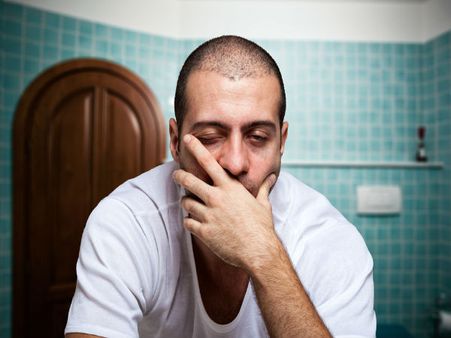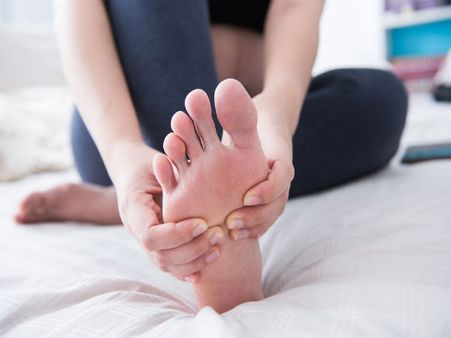Just In
- 5 hrs ago

- 6 hrs ago

- 10 hrs ago

- 11 hrs ago

Don't Miss
- Sports
 CSK vs LSG IPL 2024: Stoinis eclipses Gaikwad Heroics as Lucknow reign supreme down South
CSK vs LSG IPL 2024: Stoinis eclipses Gaikwad Heroics as Lucknow reign supreme down South - News
 Senator Lambie Calls For Elon Musk's Imprisonment Over Wakeley Church Stabbing Posts
Senator Lambie Calls For Elon Musk's Imprisonment Over Wakeley Church Stabbing Posts - Finance
 25% Dividend Record Date: Logistic Stock Nears 1-Year High And It Belongs To Mahindra; Motilal Neutral
25% Dividend Record Date: Logistic Stock Nears 1-Year High And It Belongs To Mahindra; Motilal Neutral - Education
 Telangana Inter Manabadi 1st and 2nd Year Results 2024 to be Declared Tomorrow
Telangana Inter Manabadi 1st and 2nd Year Results 2024 to be Declared Tomorrow - Movies
 Digangana Suryavanshi Gets Ready For Her Next Film 'Krishna From Brindavanam'- See Mahurat Pic
Digangana Suryavanshi Gets Ready For Her Next Film 'Krishna From Brindavanam'- See Mahurat Pic - Automobiles
 Chrysler Pacifica Marks Seven Years As Most Awarded Minivan With New Campaign
Chrysler Pacifica Marks Seven Years As Most Awarded Minivan With New Campaign - Technology
 Xiaomi Robot Vacuum Cleaner S10, Handheld Garment Steamer, and Redmi Buds 5A Launched in India
Xiaomi Robot Vacuum Cleaner S10, Handheld Garment Steamer, and Redmi Buds 5A Launched in India - Travel
Kurnool's Hidden Gems: A Guide To Exploring India's Lesser-Known Treasures
17 Signs And Symptoms Of Iron Deficiency
Our body requires iron to make healthy red blood cells (RBCs) so that it can help in the transportation of oxygen from the lungs to other parts of the body. Iron is an important nutrient in the making of haemoglobin, a protein found in RBCs that enables oxygen transportation all over the body. Deficiency of iron can cause deficiency of haemoglobin in the cells, making them less efficient to supply oxygen, hence leading a person to a condition called anaemia.

What Is Iron Deficiency?
Iron deficiency is a condition in which the balance between the iron intake, iron stored and iron loss by the body gets disturbed causing an impact on the production of healthy red blood cells. In simple terms, iron deficiency is caused mainly due to three reasons: insufficient consumption of iron, decreased absorption of iron by the body and blood loss from the body.
Iron is an important mineral that helps in the production RBCs. Many factors cause iron deficiency like gender, age and socioeconomic status. It is more common in older people; however, it is commonly seen in people who consume less iron-based foods, have a decreased tendency to absorb iron or have a more systematic iron requirement (during pregnancy). [1]

What Happens To Our Body In The Deficiency Of Iron?
Iron deficiency is common among children and women aged 15-44. Around 10-20 per cent of women are anaemic in developed countries during puberty. Children with iron deficiency are at higher risk of impairment related to learning ability that cannot be reversed. In adults, deficiency of iron causes low productivity, low metabolic rate and impaired immune system. Iron during pregnancy is very crucial as deficiency of it can cause complications like premature birth, low birth weight and postpartum depression. [2]
Signs And Symptoms Of Iron Deficiency

1. Weakness
Feeling weak is one of the main symptoms of iron deficiency. Iron helps in the production of haemoglobin, a protein which is responsible for the transportation of oxygen to all body parts. When iron levels lower in our body, the supply of oxygen reduces causing weakness.

2. Brittle nails
The condition is also known as Koilonychia identified by cracked nails which are concave in shape, flat and thin. Brittle nails usually occur during severe cases of iron deficiency. [3]

3. Fatigue
It is a condition in which a person feels sluggish and exhausted all the time. Fatigue happens as a result of reduced oxygen supply to body parts which makes them deprived of energy. [4]

4. Cracks in the mouth corners
This condition is known as Angular cheilitis identified by the development of red patches, sores or cracks in the corners of the mouth. Low haemoglobin in red blood cells is the cause of the condition. [5]

5. Dizziness
When a person feels that everything is spinning around. They also feel weak, unsteady or woozy. It happens due to the poor supply of oxygen to the brain due to the absence of haemoglobin.

6. Tongue inflammation
Mouth gives a clear indication of the lack of iron in our body. Glossitis is a condition in which tongue becomes swollen, pale and inflamed due to lower levels of myoglobin in the red blood cells.

7. Cold hands and feet
Due to the poor supply of blood throughout the body, the peripherals of the body, like feet and legs, are unable to receive enough RBCs which are required by their tissues to function. This makes the hands and feet cold.

8. Hair loss
Though it is a normal condition, hair loss is treated as a symptom of iron deficiency when the hair fall becomes more than normal. There is not much evidence to prove it, but medical experts believe that hair loss can be minimized when iron deficiency is treated. [6]

9. Chest pain
When the number of oxygenated red blood cells decreases due to iron deficiency, the heart has to work more than the normal to supply enough nutrients required by our body. This tightens the muscles of the heart leading to chest pain.

10. Pale skin
Haemoglobin is responsible to give blood its red colour. When the count of haemoglobin decreases, the blood becomes pale which is reflected through the skin. It can either occur all over the body or just in some parts like face and lower eyelids. [7]

11. Sensitivity to temperature
Poor temperature regulation in our body is due to poor thyroid function caused due to the deficiency of iron. This leads to an imbalance between heat production and heat loss rates by our body. [8]

12. Difficulty to focus
Sometimes iron deficiency can be the root cause of poor concentration, poor productivity, anxiety, depression and general restlessness. It happens due to the insufficient supply of oxygenated blood to the brain causing a decrease in concentration and ability to focus.

13. Slow cognitive and social development
Iron deficiency is associated with cognitive impairment and long-term behavioural changes. Especially in children, lack of iron during the early stage can cause a disturbance in cognitive and visuomotor development. [9]

14. Cravings for paint, hair or dirt
This is the vital sign of iron deficiency which cannot be ignored. The condition is called Pica characterised by compulsive eating of substances which are non-nutritive or non-eatables. Pregnant women and preadolescents are more prone to the condition. [10]

15. Heart palpitation
It is a feeling of irregular heartbeats, fast-beating or pounding heart. Due to the lack of haemoglobin-rich red blood cells, the heart works harder to maintain the proper blood supply throughout the body. This leads to heart palpitations. [11]

16. Restless leg syndrome (RLS)
It is an uncontrollable urge to move legs due to an unpleasant sensation. This syndrome is common and the most under-recognized symptoms of iron deficiency. RLS leads to poor sleep quality, increased tiredness, decreased sleep time and decreased energy. [12]

17. Urge to eat ice
The condition is known as Pagophagia or ice pica characterised by a compulsive behaviour of eating ice repeatedly. A hypothesis suggests that eating ice increases alertness and cognitive function in iron-deficiency individuals who had recently experienced sluggishness or decreased concentration. [13]

Foods Rich In Iron
Foods which are packed with iron are as follows:
- Spinach
- Organ meats and red meat
- Legumes
- Quinoa
- Pumpkin seeds and cashews
- Broccoli
- Dark chocolate
- Fish
- Flaxseeds
- mushrooms
- Hematocrit: To determine the volume percentage of red blood cells in the body to the total volume of blood by the process of centrifugation.
- Ferritin test: To determine the level of a blood protein called ferritin that contains iron. Low levels of ferritin indicate low iron stored in the body.
- Haemoglobin test: To measure levels of haemoglobin the body. The normal haemoglobin count in women is 11.6- 15 g/dL and for men, it is 13.2-16.6 g/dL.
Common FAQs
1. How to diagnose the deficiency of iron in the body?
There are several tests which help diagnose the deficiency of iron in the body. They are as follows:
Other tests include checking the RBCs size and colour, endoscopy, ultrasound and colonoscopy.
2. What are the 3 stages of iron deficiency?
The three stages of iron deficiency are pre-latent, latent and IDA. In the pre-latent stage, the iron storages in the muscles and the liver start to deplete with no anaemia. In the latent stage, the stored iron fully goes down but haemoglobin levels remain normal. At last, in the IDA stage, the ferritin levels go down along with a decrease in haemoglobin and hematocrit levels.
3. How to identify an anaemic by the eyes?
Paleness of the waterline of the eyes indicates the deficiency of red blood cells in the body. Iron deficiency also causes dark circles under the eyes.
4. Why doesn't the body absorb iron?
In certain medical conditions like celiac disease or Crohn's disease, the intestines become inefficient to absorb iron required by our body. Malabsorption of iron can also occur due to surgery of the intestines or side effect of certain drugs.
5. Can you be hospitalized for iron deficiency?
If there are mild symptoms of iron deficiency like paleness, fatigue, chest pain and cold feet, a person is unlikely to get hospitalized. However, when the symptoms left untreated can cause serious complications like a heart attack which require hospitalization.
-
 kidsSigns And Symptoms Of Anaemia In Children
kidsSigns And Symptoms Of Anaemia In Children -
 postnatalDoes Iron Deficiency Anaemia Affect Breastfeeding? Causes, Impacts, Risk Factors And Preventions
postnatalDoes Iron Deficiency Anaemia Affect Breastfeeding? Causes, Impacts, Risk Factors And Preventions -
 disorders cureMicrocytic Anemia: Symptoms, Causes, Risk Factors, Treatment, And Prevention
disorders cureMicrocytic Anemia: Symptoms, Causes, Risk Factors, Treatment, And Prevention -
 disorders cureCan Periods Lead To Anaemia? Who Is At Risk?
disorders cureCan Periods Lead To Anaemia? Who Is At Risk? -
 disorders cureAnaemia In Men: Possible Causes And Symptoms
disorders cureAnaemia In Men: Possible Causes And Symptoms -
 wellnessWhy Women Should Include Mangoes In Their Diet - 10 Evidence-Based Reasons
wellnessWhy Women Should Include Mangoes In Their Diet - 10 Evidence-Based Reasons -
 nutritionWhy Should You Consume Dates Soaked In Milk?
nutritionWhy Should You Consume Dates Soaked In Milk? -
 wellness11 Evidence-Based Health Benefits Of Arjuna
wellness11 Evidence-Based Health Benefits Of Arjuna -
 wellnessWhat Are The Healthy Food For Teenage Girls?
wellnessWhat Are The Healthy Food For Teenage Girls? -
 wellnessFrom Diabetes And Anaemia To Hypothyroidism, Know About The Causes Of Cold Feet
wellnessFrom Diabetes And Anaemia To Hypothyroidism, Know About The Causes Of Cold Feet -
 prenatal11 Iron-Rich Foods For Pregnant Women
prenatal11 Iron-Rich Foods For Pregnant Women -
 wellnessBeta-thalassemia: Causes, Symptoms, Risk Factors, Treatment and Prevention
wellnessBeta-thalassemia: Causes, Symptoms, Risk Factors, Treatment and Prevention


 Click it and Unblock the Notifications
Click it and Unblock the Notifications



